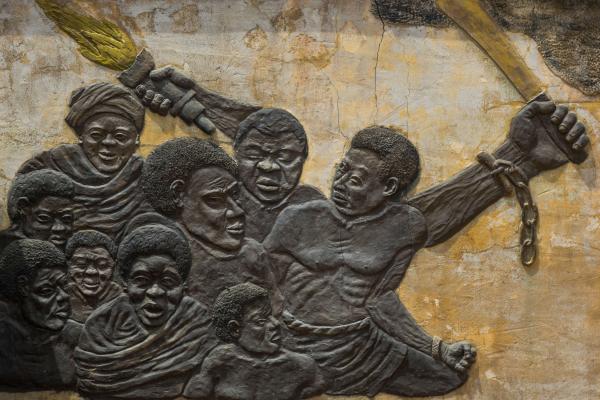The United States has a long history of blaming immigrants for our problems. This misplaced blame fuels the fears of “invasion” and creates a false image of a deadly war between innocent native-born populations and corrupting foreigners. Instead of “welcoming the stranger,” we project our problems on those who are vulnerable. We perpetuate scapegoating instead of investing in the transformation needed to save lives.
One of the things immigrants get blamed for most often? Drugs.
By the 1870s, much of the deadly and difficult work of building this nation’s transcontinental railway system was finished. But the Chinese immigrants who made that work possible were made scapegoats for a wide variety of economic and cultural woes.
At the time, opium products were more readily available in the United States than cigarettes would be in the 1970s. Opium derivatives were sold mixed with alcohol, in “patent medicines,” and an injection of morphine was a go-to solution for doctors of the day. When signs of problematic usage became evident, our country didn’t engage in a wholesale examination of the proper role of opioids in society or an examination of the conditions that brought about problematic usage but found a scapegoat: Chinese immigrants.
Opium smoking, the most popular form of usage among Chinese immigrants, was singled out for condemnation and the first legal restrictions of opium usage. Warnings that Chinese immigrants and their “opium dens” threatened the moral fabric of American society spread across the country. Doctors warned that opium smoking heightened sexual arousal and would bring about “miscegenation” between Chinese men and European women.
These resentments were deadly. 1871 marked one of the largest lynchings in United States history that claimed the lives of at least 17 immigrants who were shot, mutilated, and hung to death. Laws targeting Chinese immigrants continued and by 1882, Congress passed the Chinese Exclusion Act that barred the immigration of all Chinese laborers into the United States.
These dynamics are at work again today. In 2017, more than 70,000 people in the United States died from an overdose. The devastation of this crisis is real. People across the United States are afraid of what they see happening to their children, friends, loved ones, and communities. They are searching for answers. Sadly, the loudest voices have been those doing the scapegoating and warning of an “invasion” that is bringing drugs, gangs and crime.
Would the “wall” do anything to reduce drug deaths in America?
No. It would waste resources that could help. Here is why. The substance driving overdose deaths today is illicit fentanyl. It is a powerful synthetic opioid 50-100 times stronger than heroin. It is an important drug for relieving severe pain when administered medically and incredibly dangerous when purchased on the black market where users are uncertain as to their dosage. Just the right amount means relief from debilitating pain. Just a few milligrams more might mean an overdose.
90 percent of the world’s illicit supply of fentanyl is manufactured in China. The two most common ways it enters the United States is when it is ordered and shipped directly on the “dark web” or when it is sent to Mexico first and then smuggled across our southern border.
Given these realities, shouldn’t we blame China? Shouldn’t we build the wall to cut off any drugs coming through the southern border?
Here is the problem with that approach. Most drugs that are smuggled across our southern border come through legal ports of entry, not in between where “the wall” is being built. According to United States Customs and Border Protection statistics, 90 percent of heroin and 80 percent of fentanyl were captured at ports of entry. This isn’t just because ports of entry are where we have resources to detect and stop drugs, but because that is where drugs are usually smuggled.
Why? It is easier and more cost efficient to send a lot of drugs hidden in cars and trucks knowing that some will get found and stopped than it is to try and have individuals carry those drugs through the desert knowing that some will still get captured. A wall will cost a lot but do little to effect how drugs typically enter the country.
But the problem is deeper than just whether or not enforcement measures are effective. Even if the U.S. could seal off our borders entirely and capture every ounce of fentanyl smuggled in, it wouldn’t solve our overdose crisis. Since fentanyl is a synthetic opioid, unlike heroin, it doesn’t need a base of opium to be produced but can be synthesized in a lab anywhere in the world. Cutting off an international supply of illicit fentanyl would just mean more manufacturing would happen domestically.
How do we know? Here in my home state of New Hampshire, we have one of the highest illicit fentanyl overdose rates in the country. Far from the southern border, the drugs here aren’t coming from China via Mexico or even directly from China. A recent report from Geisel School of Medicine at Dartmouth concluded that most of the fentanyl in the state is manufactured and distributed locally.
We don’t have an addiction and overdose problem in the United States because foreigners have invaded with drugs; drugs come in to the United States because of the demand created through addiction. If we don’t address the demand side of the equation, efforts at supply reduction are just an expensive and deadly form of “whack a mole.” Our current front line efforts through criminalization and incarceration aren’t just ineffective, they make the problem worse.
Renee Girard, the historian and theologian, helped the world better understand the “scapegoat” mechanism at work. Throughout human history, societies tend to misidentify the core of their problems. Instead of looking inward, we create or identify an “other” — a scapegoat — to take the blame. It can provide a temporary sense of relief or progress because everyone thinks they have found what is going wrong, but it fails to address the core problems at stake.
Fear of “invasion” led a shooter to gun down 31 people outside of a Walmart in El Paso. Fear of “invasion” is driving the building of a wall at our southern border, systemic injustices towards migrants and asylum seekers, and an erosion of legal pathways to immigration. Fear of “invasion” is driving anti-immigrant sentiment making the country less safe for us all.
Part of the work in creating a society that welcomes and celebrates immigrants it to dismantle the lies that are being told about them. We need to speak the truth about drugs, addiction, and the overdose crisis, not just for the sake of those who are suffering directly, but for our immigrant brothers and sisters, whose lives, families, and livelihoods are threatened by unjust blame.
Got something to say about what you're reading? We value your feedback!







